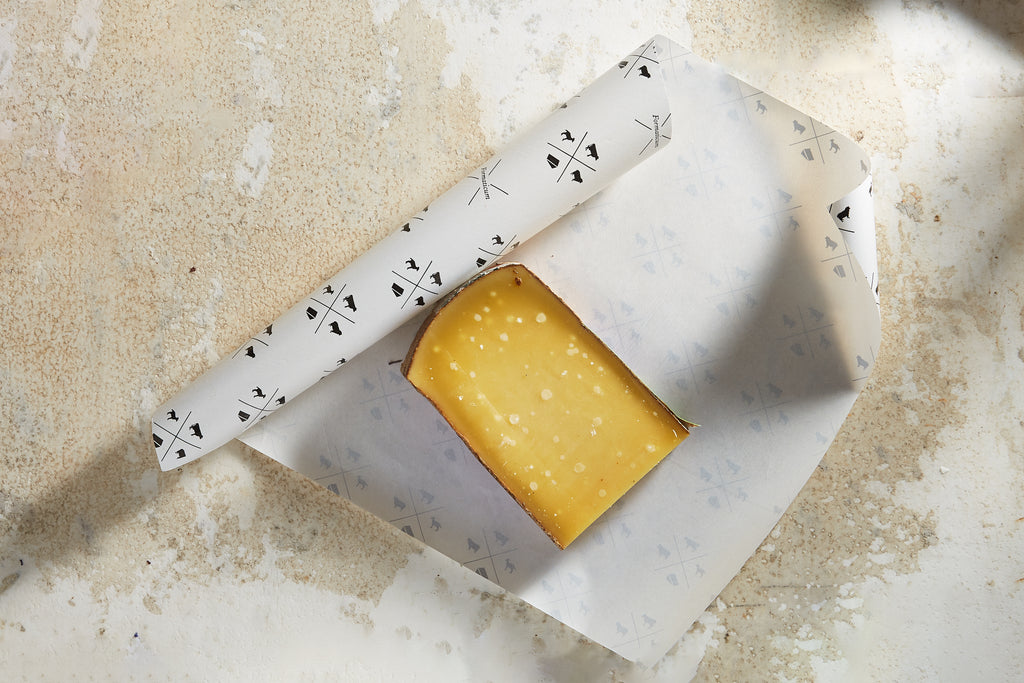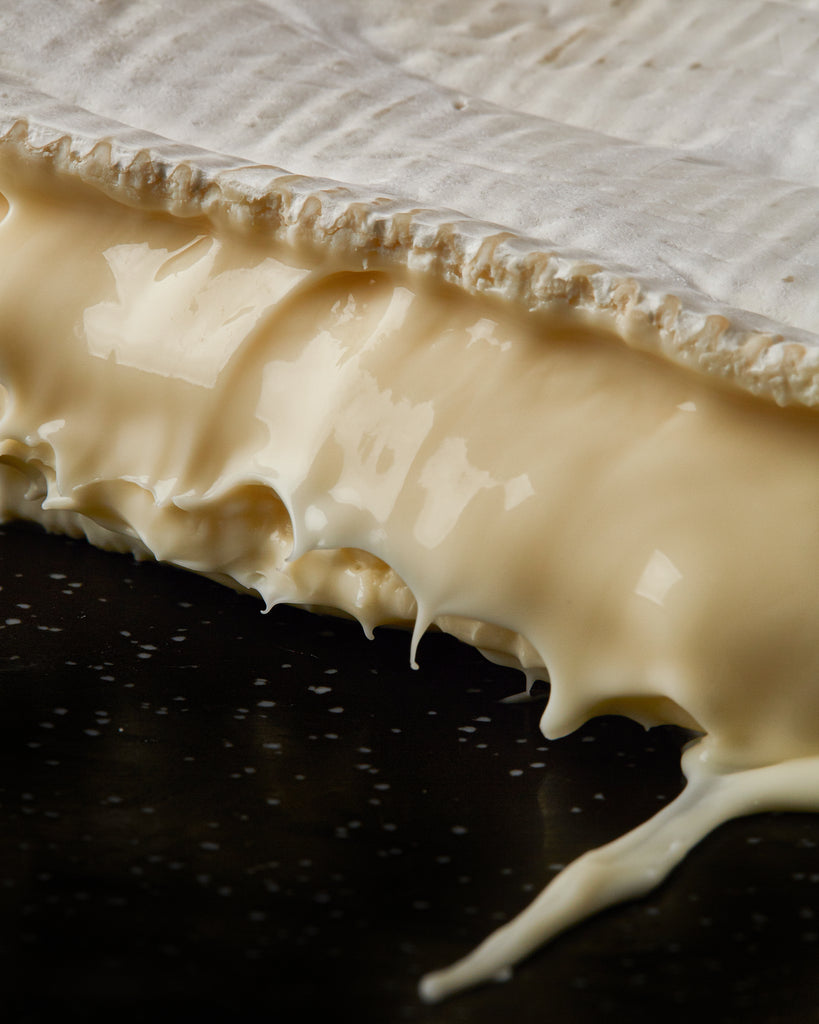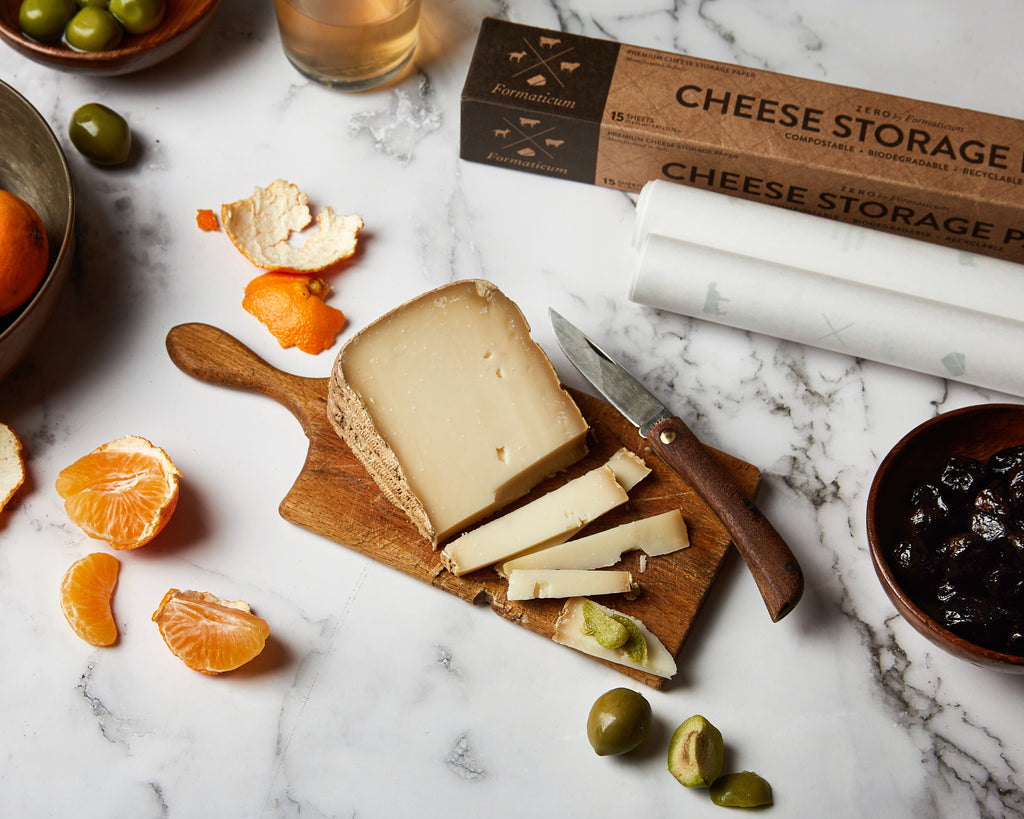All About Alpage - An Ancient Swiss Tradition

The end of the summer marks an important tradition for Swiss cheesemakers - the Désalpe. After a long summer high up in the Alps, the farmers lead their herds of cows down the mountain and parade them through the town, adorned with flower crowns and ornate cowbells as the town cheers to thank them for their hard work. Attendees of the Désalpe celebrate the end of the summer cheesemaking season with fondue, drinks, and heaping plates of food, as the sounds of traditional Swiss alphorn music mingle with the clanging of the cowbells.
The celebration comes at the end of the alpage cheesemaking season - during the summer months, farmers and cheesemakers make their way up into the mountains with their cows to spend the season in chalets, Alpine huts that often have no electricity. Some farmers even combine their herds in order to pool milk for a single cheesemaker to work with - this is called coop dairying, a tradition that is very common for cheeses like Gruyère and Comté. While the cows graze on the lush mountain pasture, the town below can focus on utilizing their pastures to harvest and store hay for the herds to eat during the harsh winter months. The seasonal migration of the animals from lower to higher elevations across seasons is known as transhumance, and it is not exclusive to Swiss cheesemaking - many cheeses like Gorgonzola from Italy and authentic Cotija from Mexico involve transhumance too!
The abundance of diverse flora, grasses, and herbs present in high elevation Alpine pastures are a significant part of what gives alpage cheese its unique and complex flavor - as the cows digest them, their flavors create a terroir in the milk is distinctly Swiss, which only intensifies as the cheese ages. The milk is collected daily, sometimes more than once, where it is made into cheese in a copper vat over a wood-burning fire, imbuing the wheels with a hint of wood smoke.
Over hundreds of years, alpage cheesemakers have come up with ways to achieve the ideal firm texture and savory, nutty flavor of their cheeses as a result of immediate environmental factors - from cutting the curds smaller and heating them at a higher temperature to create a drier cheese, to a sparing use of salt to avoid lugging heavy bags up a mountain, to a standardized larger format wheel that is easier to bring back down the mountain than several smaller wheels. Creating larger, sturdier wheels of cheese ensures the cheese will stay good longer so that the people in the community can consume the nutrients found in liquid milk to help sustain them through the winter months.
Alpage cheesemaking is no small feat - it requires nearly round-the-clock commitment and backbreaking labor. Those who continue this ancient cheesemaking tradition are lauded and highly respected in Switzerland. So this season, we raise a glass and a pot of fondue to alpage cheesemakers everywhere to thank them for keeping the tradition alive, so that we can continue to enjoy our Gruyère, our Vacherin Fribourgeois, our Sbrinz, our L'Etivaz, and much more.
Of course, it's important to store these cheeses properly so that you can experience the seasonality and flavor at its best and fullest - Formaticum cheese storage solutions are perfect for protecting your investment and honoring the work of these dedicated cheesemakers and farmers. We recommend our Reusable Cheese Storage Sheets for the best possible results, or our Reusable Cheese Storage Bags for all the benefits of the Reusable material, combined with the ease of the bag format.
Shop now at formaticum.com and don't forget to enjoy some fondue with friends this holiday season!
Celebrating Raw Milk Cheese Appreciation Day - October 19th, 2024

In preparation for Raw Milk Cheese Appreciation Day coming up on October 19th, we wanted to delve a little deeper into the world of raw milk cheese to help you better understand it and hopefully inspire you to purchase a piece to celebrate the holiday!
If you have ever enjoyed a piece of authentic Swiss Gruyère in a sandwich, grated Parmigiano Reggiano over pasta, or Roquefort in a salad, you have eaten raw milk cheese. And while the concept of raw milk cheese might be unfamiliar to many right now, it is the way that cheese has been made for centuries, since cheesemaking predates the invention of pasteurization in the 1860s. But what exactly does the term mean, and why are dedicating an entire day to celebrating it?
"Raw" milk is milk that has not been pasteurized prior to being made into cheese - Eating raw milk cheese is not at all the same as drinking raw milk. Raw milk contains naturally-occurring microflora that is usually harmless if the milk is handled correctly and responsibly in a sanitary environment and made into cheese almost immediately. Pasteurization kills any existing potentially harmful pathogens within the milk, but it also kills any completely harmless, flavor-producing microorganisms. Bacteria is not always a dirty word, and in the case of raw milk cheese, the bacteria present are actual integral to the development of the cheese's individual flavor. The beneficial bacteria present in raw milk cheese also represent a natural defense against any "bad" bacteria, whereas a pasteurized milk cheese stripped of its natural defenses could present a friendlier environment for pathogens to grow. However, there is little to worry about as long as you are purchasing responsibly-made cheese from a reputable source with strict sanitation standards!
The microorganisms in raw milk are inherently connected to the concept of terroir, or how every aspect of an animal's environment affects the flavor of the cheese. The animal breed, the feed it eats, the water it drinks, all impacts the composition of the milk, which affects the flavor of the cheese. It's part of the reason why many classic European raw milk cheeses have PDO (Protected Designation of Origin) status - the terroir of these cheeses is the base of their identities, and if they were made anywhere else under different conditions, the cheese simply would not taste the same.
In fact, many of your favorite cheeses that have become household names, must legally be made with raw milk in their authentic forms - think Parmigiano Reggiano, Grana Padano, Gruyère, Comté, Brie de Meaux, Camembert de Normandie…have you ever noticed that the aged cheeses listed can probably be found in any cheese shop or specialty grocery store, but you've probably never seen a veritable Brie de Meaux or Camembert de Normandie on your store shelves? That's because the FDA here in the US has decided, to the dismay of the American cheese community, that all raw milk cheese produced in or imported into the US must be at least 60 days of age for food safety reasons. And while the author of this blog post is neither a doctor nor a scientist, it should be noted that the rest of the cheesemaking and cheese-consuming world does not look kindly upon this unique ruling.
But we should not only celebrate European raw milk cheeses - there are plenty of high-quality cheeses being made all over the world that deserve to be celebrated with just as much enthusiasm! For example, authentic Cotija from Mexico is traditionally a raw milk mountain cheese, instead of the vaguely milky stark white vacuum-sealed blocks so commonly found in the dairy section of the grocery store. Even the United States has a flourishing raw milk cheese culture (pun intended) - our country is home to rockstar cheesemakers like Uplands Cheese, Parish Hill Creamery, Shelburne Farms, Cato Corner Farm, Jasper Hill Farm, Meadow Creek Dairy, and many more who are churning out some of the finest raw milk cheese on the market that can go toe to toe with any European classics.
Raw milk cheeses contain centuries of cheesemaking history in every bite, with complex and nuanced flavor that simply cannot be replicated by any machine in any lab. If you have made the effort to seek out high-quality cheese at peak flavor, you certainly want to make sure that you preserve that flavor to the best of your ability! Formaticum cheese storage products are the best way to ensure that you taste every bite as the cheesemaker intended - our products allow you to protect your investment and simultaneously honor the work of every animal and person that helped create that cheese and get it to your plate.
And just as there is a cheese for every palate, there is a Formaticum product for every lifestyle:
Classic Cheese Storage Bags are perfect for cheese lovers of all experience levels, and make it easy to store any cheese in your fridge - simply place the cheese in the bag, fold the top over, and enjoy a piece whenever you want!
Reusable Cheese Storage Bags are our newest addition to the collection and are an ideal solution for anyone looking to reduce kitchen waste - they can be hand-washed, air-dried, and reused indefinitely for all styles of cheese.
Zero Cheese Storage Sheets are an eco-friendly option that can be composted right in your backyard!
Browse our full collection of cheese storage solutions on our site, and contact us with any questions or comments at hello@formaticum.com.
Vive le fromage!
Can I Eat the Rind?

Charles de Gaulle once famously asked, "How can you govern a country with 246 varieties of cheese?" and while the actual number of cheese varieties in France and worldwide is much, much higher, it really makes you think - with all those different cheeses comes an equal amount of cheese rinds. But which ones are edible, and more importantly, which ones are delicious? We can't help you with deciding the latter, since everyone's tastes are different, but we can certainly provide you with a handy guide to cheese rind types and how to approach them.
First, a bit of cheese anatomy: the "rind" is the outer, usually harder, part of the cheese, and the "paste" is the inner, softer part of the cheese that is surrounded by the rind.
As a general rule, all cheese rinds are edible unless they are made of an inedible material, as on a Clothbound Cheddar or a waxed Gouda. But how can you tell rinds and cheese styles apart? Use the tips below to learn how to identify cheese types and also how to store them properly, since cheese is a living product!
Bloomy Rind: Perhaps the most universally recognized rind, this fluffy white outer layer is formed by the culture p. candidum or camemberti, and can sometimes include a speckling of grey, blue, or even green molds that should not be feared - they indicate that the cheese is alive and healthy! This category of cheese includes favorites like Brie, Camembert, triples creams, and even some Robiolas.
Geotrichum Rind: Bearing a striking, almost brain-like appearance, this type of rind is created through the growth of the culture geotrichum candidum. Most commonly found on small-format aged goat cheeses like Chabichou, Mothais Sur Feuille, and Langres, these iconic wrinkles usually denote a tangy, bright, sometimes yeasty flavor.
Both of these rind types are completely edible and in fact are painstakingly developed by affineurs (cheese aging professionals) to enhance the character of the cheese and complete the flavor experience.
Because these rinds require a bit of extra oxygen to thrive, the best wrapping material for Bloomy & Geotrichum-rinded cheese is our Clear Storage Sheets.
Washed Rind: You might smell this rind before you see it - the culture b.linens is responsible for creating a tacky, orange rind with funky, sometimes beefy scent. Think Epoisses, Taleggio, and Raclette. This rind is completely edible and will intensify as the cheese ripens! Store washed rinds in our plastic-free Zero Cheese Storage Sheets for best results.
Natural Rind: These are the cheeses that look craggy and mottled - as the name suggests, these rinds are aged naturally using ambient microflora in an aging cave. Examples of this particular kind of natural rinded cheese include some tommes like Ossau Iraty or Garrotxa, both rinds that are technically edible but may taste a bit too intensely earthy or "cavey" for some cheese lovers. Some natural rinded cheeses like Gruyère and Comté are also gently washed in brine while they are aged in an environment that encourages the growth of naturally occurring molds to help form the rind. These rinds can certainly be eaten and enjoyed, but may have a stronger earthy or mushroomy flavor.
Other notable natural rinds include real Parmigiano Reggiano and Grana Padano (it's not wax!) and Mimolette, which is famously ripened with the help of the completely harmless and incredible important cheese mite. While these rinds are generally too hard to be eaten on their own, Parmigiano rinds can be added to soups, sauces, and stocks to enhance the flavor.
Use our Classic Cheese Storage Bags to keep natural rinded cheeses fresh in your fridge, as they can generally hold their shape better than softer cheeses and will thrive in the cave-like environment created by our Cheese Storage Bags.
Blue Cheese: Generally, you will encounter two types of rinds on blue cheeses: natural, such as with Stilton or Bayley Hazen Blue, or foil-wrapped, for example, Roquefort or Point Reyes Original Blue. Both rinds are natural and edible (obviously not the foil itself but the rind beneath), but it is not necessary to consume them to experience the full flavor of the cheese. Some blue cheeses are wrapped in leaves, like Rogue River Blue or Shakerag Blue, and the leaves on cut pieces, like foil, should be left on for as long as possible, as they offer a level of protection for the rind.
Try wrapping blue cheeses in Reusable Cheese Storage Sheets, a sturdy cheese storage solution that will preserve your cheese and prevent leakage.
Got a question on your rind? Reach out to us any time at hello@formaticum.com!
Not All Pecorino Is Created Equal: A Beginner's Guide to Sheep's Milk Cheese

When you hear the word "pecorino," your first thought is most likely Pecorino Romano, Italy's salty, briny specialty sheep's milk cheese known most widely for its role in the dish cacio e pepe. But not all pecorino is created equal, and in fact the word "pecorino" does not denote one particular cheese - instead, it is simply a generic term for any cheese made from sheep's milk, as the word is derived from the Italian "pecora" meaning "sheep". Pecorino is made all over the boot, in hundreds of varieties, and included in the regional cuisine of nearly all 20 regions of Italy. From the tomato paste-rubbed Pecorino Marzolino of Tuscany to the gently smoked Pecorino Fiore Sardo of the island of Sardegna, sheep's milk cheese is an important part of Italian culinary history that reflects the gastronomic traditions of the areas where it originated.
But sheep's milk cheese is not exclusive to pecorino or even to Italy; in fact, sheep were the first animals domesticated for milk production in the Fertile Crescent, which is the Middle East today. Evidence of sheep’s milk cheese can be found throughout history, dating back to the Roman Empire. It has also been written about for centuries, most notably in Homer’s Odyssey, which mentions a ewe’s milk cheese made by the cyclops Polyphemus.
There are a few reasons why sheep's milk is particularly suited for cheesemaking - first, the solid components of sheep's milk (fat, protein, lactose) are higher than cow's milk, meaning a higher yield of cheese. Sheep's milk also contains more flavor-producing short chain fatty acids, as well as conjugated linoleic acid that has been known to support your immune system.
With all this in mind, of course it makes sense that some of your favorite iconic cheeses are made exclusively with sheep's milk! We have sheep to thank for household favorites like Manchego and Ossau Iraty, as well as cheesemonger favorites like the custardy torta-style cheeses from Spain and Portugal. The USA is also home to stellar sheep's milk cheesemakers like Landmark Creamery, Green Dirt Farm, and occasionally Blakesville Creamery, who are usually known for their award-winning goat milk cheeses from Wisconsin but occasionally foray into sheep milk territory.
But while sheep's milk cheeses are delightfully delicious, they can also be a bit more difficult to store at home to keep them in peak condition. Formaticum Cheese Storage Bags are the perfect way to prevent your precious wedges from drying out in the fridge or taking on unwanted flavors or aromas. Try our new Reusable Cheese Storage Bags for an added level of protection from the excess butterfat typical of aged sheep's milk cheese - while our classic bags should be recycled at the sight of a butterfat stain, Reusable Bags can be hand-washed, air dried, and reused again and again - they're a cheese's best friend!
And don't forget to use our greaseproof Board Liners for your next cheese platter or grazing table featuring sheep's milk cheese, especially in the summer heat!
Shop professional cheese storage solutions at formaticum.com.

Formaticum News
Our home to share our cheese chronicles and more.
Categories
Recent Posts
Formaticum in France: Go For Beaufort
Cheesemonger Champions: Team USA's Journey to the Mondial du Fromage
Breaking Down Burrata: A Guide to Mozzarella & Friends
Upcoming Events
Connect with Us
Join the Newsletter
Sign up to receive special offers, new product releases, updates from the cheese shop, and more.









